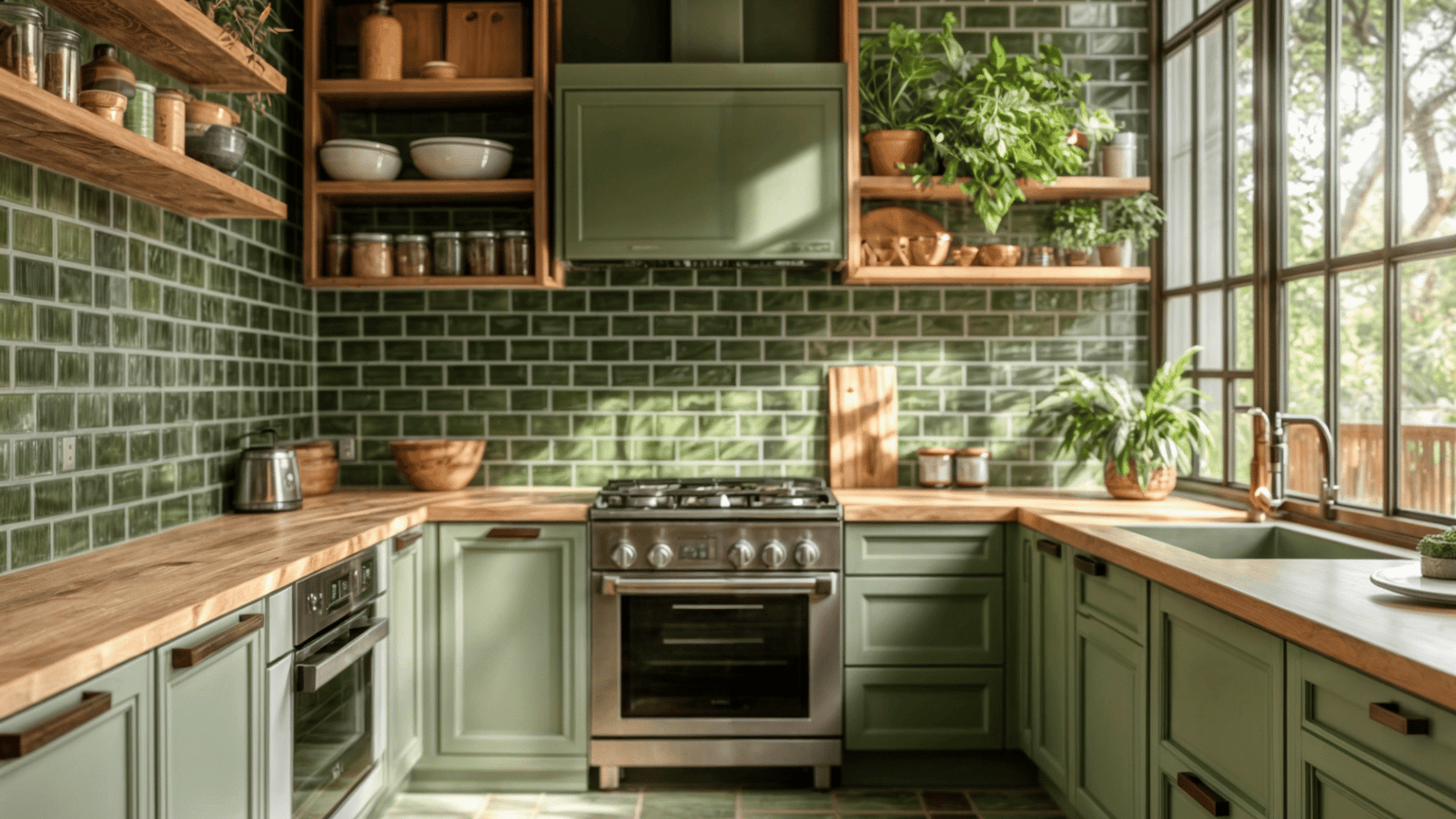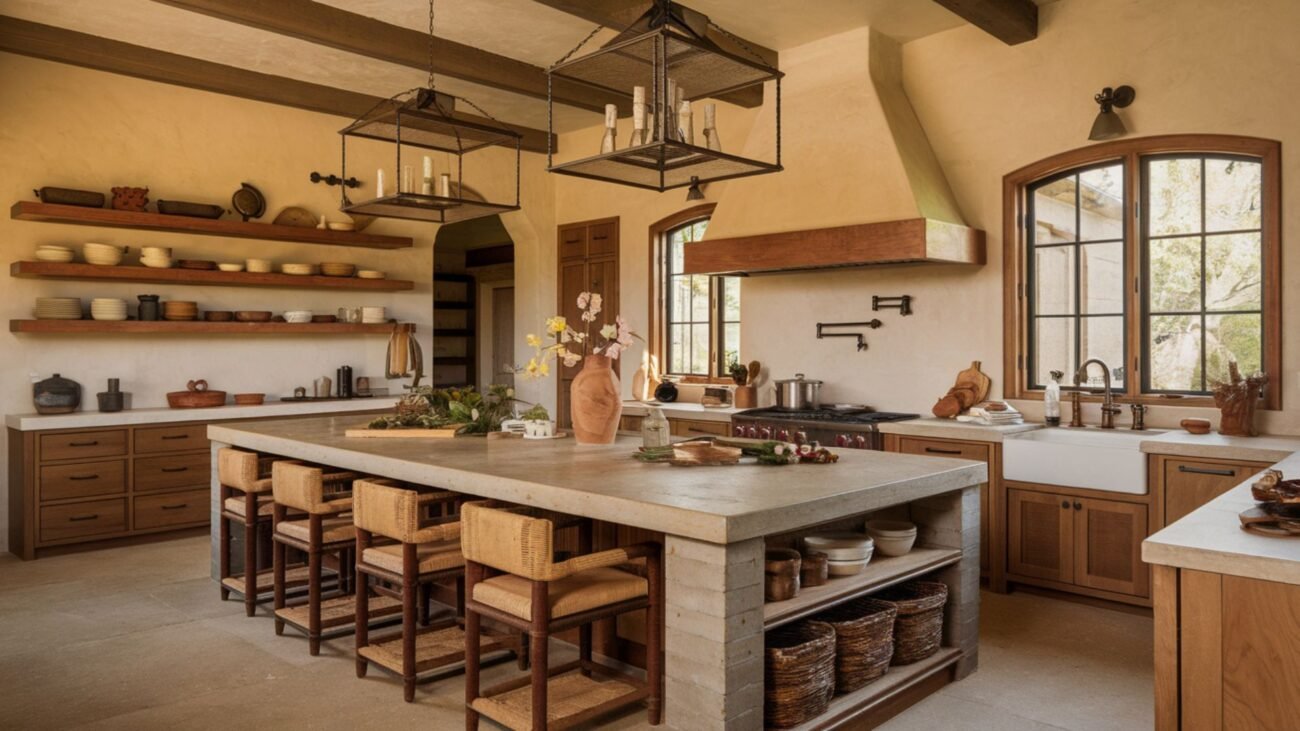Designing an Elegant Green Kitchen
In an elegant green kitchen, the color palette serves as both a visual anchor and a source of tranquility. Opt for soft sage or deep forest hues that evoke the lushness of nature, creating a serene backdrop for culinary creativity. To enhance this natural theme, consider incorporating textured materials like reclaimed wood or stone countertops, which not only add depth but also tell a unique story about sustainability and craftsmanship.
Lighting plays a pivotal role in showcasing the elegance of your chosen green tones. Embrace large windows to capture ambient daylight and accentuate the vibrancy of your design elements. Additionally, pendant lights made from woven materials can introduce organic shapes and soften hard surfaces while providing warm illumination during evening gatherings. Integrating indoor plants—such as herbs on your windowsill—can further connect your kitchen to the outdoors, promoting a sense of harmony with nature while infusing freshness into every meal preparation.
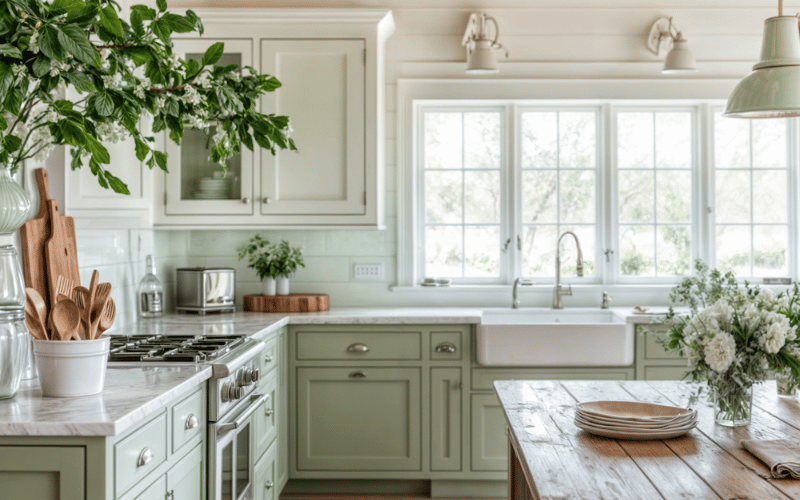
Choosing the Right Color Palette
Selecting the right color palette is crucial in creating an elegant green kitchen that harmonizes with natural elements. Start by considering shades of green that evoke tranquility and freshness, such as soft sage or deep forest greens, which can create a serene backdrop for your culinary space. To enhance this foundation, introduce complementary hues like creamy whites or warm beiges to add warmth without overshadowing the lushness of green. These lighter tones not only brighten the area but also create a clean canvas that allows your natural elements—like wooden cabinetry or stone countertops—to shine.
Don’t shy away from incorporating accent colors inspired by nature, such as muted blues reminiscent of a clear sky or earthy terracotta that echoes terracotta pots and natural clay. These accents can be strategically used in accessories, textiles, or even feature walls to break up the monotony and enliven the space while maintaining overall cohesion. Remember to consider how natural light interacts with your chosen palette; sunlight can alter perceptions of color throughout the day, so sample swatches in various lighting conditions before making final decisions. A thoughtfully curated color scheme will not only elevate your kitchen’s aesthetic but also foster a conversation between elegance and nature that transforms daily cooking into an inspiring experience.

Incorporating Natural Materials and Textures
Incorporating natural materials and textures into your kitchen design transcends mere aesthetics; it fosters a profound connection between indoor spaces and the surrounding environment. Consider integrating reclaimed wood not just for cabinetry, but also for open shelving or as accents on kitchen islands. The rich history embedded in these materials tells a story of sustainability while bringing warmth and character to modern designs. Pair this with organic textiles—like linen or cotton—for window treatments or chair cushions that add softness without overwhelming the space.
Natural stones, such as marble or granite, can serve as striking countertops that offer both beauty and durability. Their unique veining patterns draw the eye and spark conversation, creating focal points throughout your kitchen. To further emphasize texture, bring in elements like woven baskets or clay pottery that celebrate craftsmanship and echo nature’s forms. This multi-faceted approach cultivates an inviting atmosphere where sophistication meets simplicity—a blend that inspires culinary creativity while honoring Mother Earth.
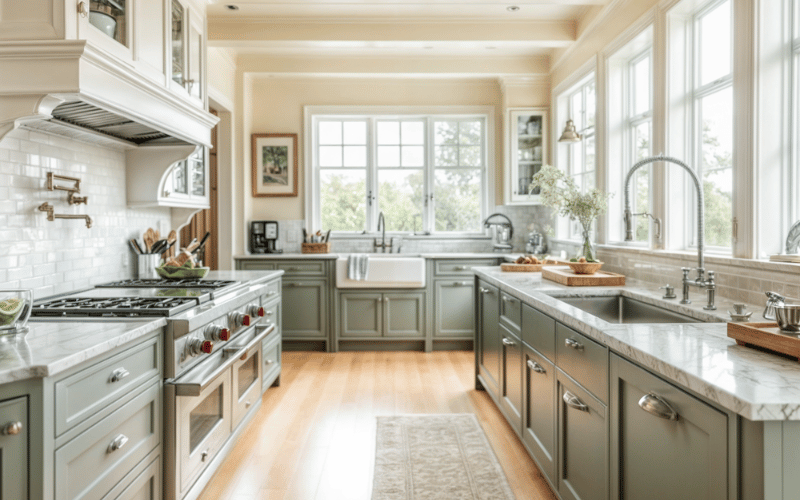
Selecting Sustainable Kitchen Appliances
When selecting sustainable kitchen appliances, consider their energy efficiency as a priority. Look for appliances with the ENERGY STAR label, which signifies that they meet strict energy efficiency guidelines set by the U.S. Environmental Protection Agency. Beyond just electricity consumption, think about the entire lifecycle of the appliance—from sourcing materials to end-of-life recyclability. Opting for brands committed to using recycled materials can reduce your ecological footprint and promote a circular economy.
Additionally, explore innovative technologies that minimize water usage in dishwashers and washing machines without compromising performance. Smart appliances that allow you to monitor energy usage in real time empower homeowners to make more informed choices while cooking or cleaning. Furthermore, integrating multifunctional devices can streamline your kitchen operations; for example, a combined microwave-convection oven reduces waste by consolidating equipment needs without sacrificing versatility or style. By choosing appliances thoughtfully and prioritizing sustainability, you contribute not only to an elegant green kitchen but also to a healthier planet.
Maximizing Natural Light in the Space
Maximizing natural light in your green kitchen not only enhances the space’s aesthetic appeal but also fosters a vibrant atmosphere that harmonizes with nature. Consider strategically placing mirrors to reflect and amplify sunlight; a well-placed mirror can double the impact of light, making your kitchen feel airy and expansive. Additionally, opt for lighter color palettes on walls and cabinetry, which not only brighten up the room but also create a canvas that works in tandem with natural light.
Incorporating large or multipurpose windows can transform standard cooking spaces into sunlit sanctuaries. Think about window designs like skylights or bi-fold doors that invite the outside in, offering seamless transitions between nature and your culinary haven. Furthermore, using translucent materials like frosted glass for cabinetry allows natural light to filter through without compromising privacy—an elegant solution that encourages warmth while maintaining sophistication. Embrace this interplay of light within your design; it’s an opportunity to not just illuminate but invigorate both functionality and style in your green kitchen.
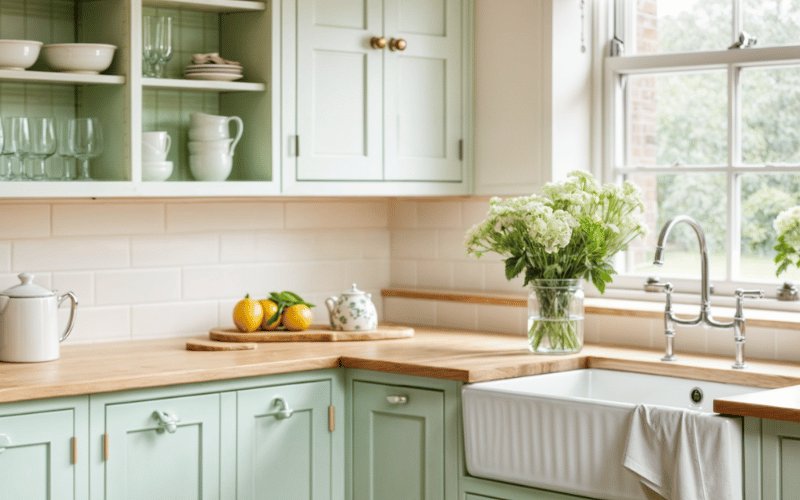
Adding Indoor Plants for Freshness
Incorporating indoor plants into your kitchen design not only enhances the visual appeal but also infuses a sense of freshness that can elevate your culinary environment. The vibrant greens of plants like basil, mint, or rosemary serve as both a decorative element and a functional herb garden. Imagine plucking fresh herbs just steps away from your cooking space—this connection to nature fosters creativity and inspires healthier meals.
Moreover, strategically placed plants can improve air quality, making your kitchen a more inviting space for family gatherings and culinary experiments. Consider utilizing vertical gardens or hanging planters if you’re short on counter space; this adds depth and intrigue to your decor while maintaining an open feel. Furthermore, the rhythmic patterns of various leaves invite a sensory experience that complements the organic materials typically found in elegant kitchens. By creating layers with different plant heights and textures, you establish an intimate atmosphere brimming with life—and there’s nothing quite like preparing food surrounded by living greenery!
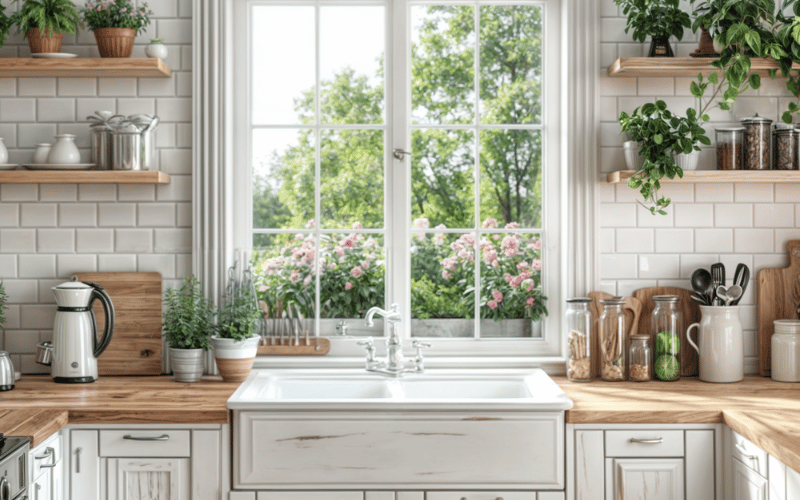
Utilizing Eco-Friendly Countertops and Cabinets
Choosing eco-friendly countertops and cabinets not only enhances the elegance of your kitchen but also significantly reduces your environmental footprint. Materials like bamboo, reclaimed wood, and recycled glass offer unique textures and colors that can harmonize beautifully with natural elements. For example, bamboo is not just aesthetically appealing; it’s a rapidly renewable resource that boasts impressive durability, making it an ideal choice for surfaces that endure daily use.
In addition to aesthetics and sustainability, incorporating eco-friendly options can elevate the functionality of your space. Many sustainable countertops feature non-toxic finishes that contribute to healthier indoor air quality by minimizing volatile organic compounds (VOCs). Moreover, selecting cabinetry constructed from FSC-certified wood ensures responsible forestry practices while adding warmth to your kitchen’s overall design. By focusing on these eco-conscious choices, you create a space that reflects both sophistication and a commitment to preserving our planet for future generations—an elegant balance between style and sustainability.
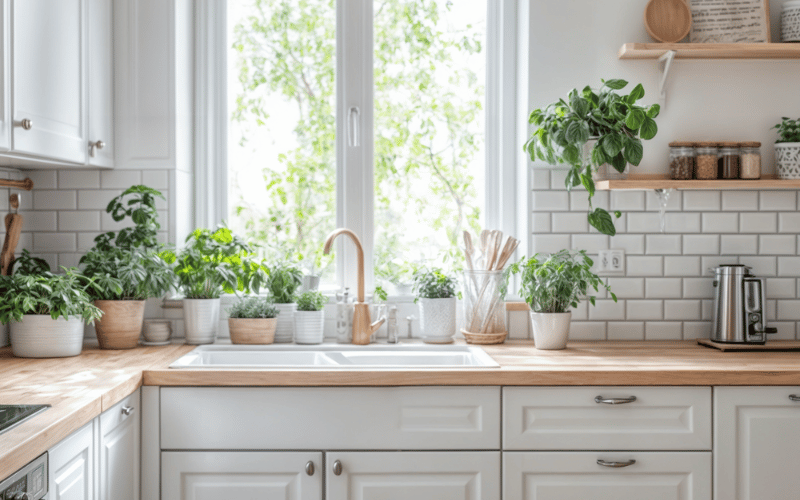
Mixing Modern and Rustic Elements
Blending modern and rustic elements in a green kitchen creates a unique atmosphere that celebrates both innovation and tradition. Imagine sleek, minimalistic cabinetry juxtaposed with reclaimed wood shelves—this contrast not only adds depth but also tells a story of craftsmanship. The warm hues of the rustic elements can soften the clean lines synonymous with contemporary design, inviting warmth into what could otherwise feel sterile. Consider incorporating industrial materials like stainless steel appliances alongside vintage wooden accents; this combination fosters a dynamic yet harmonious vibe.
Furthermore, innovative lighting choices can enhance this eclectic design approach. A contemporary pendant light above an antique farmhouse table draws the eye while uniting both aesthetics. Adding plants in ceramic or textured pots introduces natural elegance and further bridges the gap between styles, embodying both sophistication and earthiness. By thoughtfully curating each piece—whether it’s choosing an artisanal sink or selecting modern chrome fixtures—you craft a kitchen that reflects your individuality while harmonizing rustic charm with sleek modernity, creating an inviting space where culinary creativity flourishes amidst aesthetic beauty.
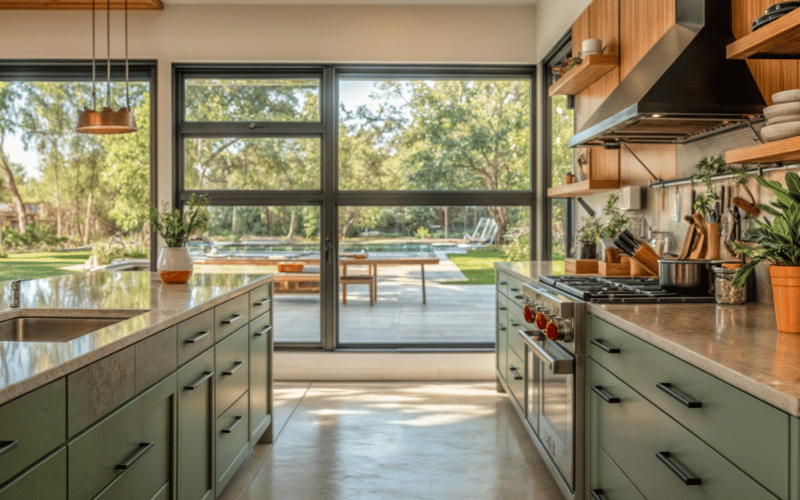
Creating a Functional Layout with Flow
A functional layout in a green kitchen goes beyond just placing appliances and cabinets; it’s about orchestrating a seamless flow that enhances both usability and aesthetics. Consider the classic work triangle of the sink, stove, and refrigerator, but reimagine this design with movement in mind. Create dedicated zones for prep, cooking, and clean-up—each inviting yet distinct—allowing for an intuitive experience during even the busiest meal preparations. Integrating natural elements like stone countertops or reclaimed wood shelving further enriches this setup, crafting a space that feels grounded and harmonized rather than cluttered.
To cultivate flow within your green kitchen, leverage open shelving to keep frequently used items close at hand while allowing light to breathe through the space. Pair this with strategically placed plants not only as decor but also as air purifiers that enhance your cooking environment. Think about how colors can guide movement: soft greens and earthy browns together will create tranquility while energizing deeper shades draw focus. With every element working in concert—from lighting fixtures that illuminate key areas to materials that feel lush underfoot—you’ll achieve not only functionality but an elegant ambiance where nature meets everyday life seamlessly.
Conclusion: Achieving Harmony in Design Choices
In the quest for an elegant green kitchen, achieving harmony in design choices transcends mere aesthetics; it cultivates a space that resonates with tranquility and functionality. Integrating natural elements like wood, stone, and plants not only enhances visual appeal but also fosters a deep connection to nature. This seamless blend encourages mindfulness in daily routines—from the calm of dappled sunlight filtering through strategically placed windows to the soothing sound of water trickling from a chic sink. Each choice we make should reflect personal value while inviting elements that harmonize with our surroundings.
Beyond physical materials, consider the emotional resonance of your kitchen. Curate pieces that tell your story—whether through artisanal dishware or heirloom utensils—and let these details breathe life into your space. By consciously balancing form and function, you create an environment where culinary creativity can flourish alongside meaningful connections with family and friends. Ultimately, an elegant green kitchen becomes more than just a cooking area; it transforms into a sanctuary that nurtures both spirits and appetites alike, embodying sustainability without compromising style or comfort.
>> Learn more: Kitchen Design Ideas and Inspiration for 2025


